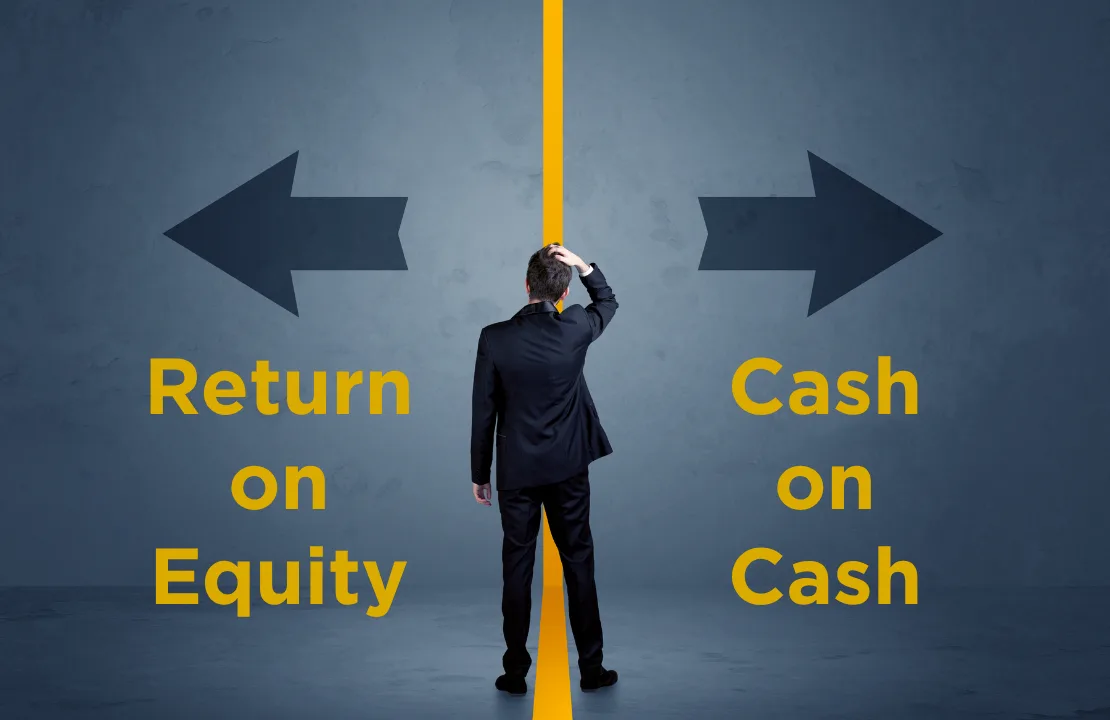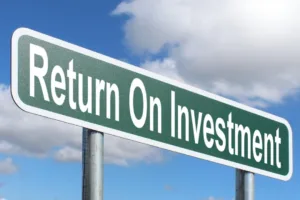Wayne had a classic winner personality. Nothing kept him down. He went from broke and living on friend’s couches as a teenager, to owning Millions in real estate by the time he was in the ‘Fun retirement’ stage.
Over time, like a lot of investors, Wayne had a huge amount of equity built up in his portfolio. Even though he would take out refi loans on existing properties to purchase more from time to time, he still had a lot of equity sitting in his real estate.
With the huge growth of real estate since 2020 (Many investors had their properties grow in value 50% or more), he had Millions sitting in equity.
A lot of investors look at the cash-on-cash return for their investments, which is helpful starting out especially.
But the Return on Equity is a measure that shows you how efficient your property is, based on your leverage.
Let’s dive in to how this looks.
Cash-on-Cash Return: The Immediate Income Lens
Definition:
Cash-on-Cash Return measures the annual pre-tax cash flow generated by a property as a percentage of the initial cash invested.
Formula:
Cash-on-Cash Return = Annual Cash Flow Before Taxes / Total Cash Invested
Example:
Suppose an investor buys a 20-unit apartment building for $2,000,000. They put down $500,000 in cash (25%) and finance the rest. After collecting rents and paying expenses and debt service, the property generates $50,000 in annual cash flow.
$50,000 / $500,000 = 10%
This metric tells the investor how much “spendable cash” they are getting back on their initial investment each year. For investors focused on short-term income or comparing the immediate performance of different deals, CoC is invaluable.
Key Insight:
Cash-on-Cash Return does not account for appreciation, loan paydown, or changing equity. It’s a snapshot of the immediate income return on the cash invested today.
Return on Equity: The Long-Term Performance Lens
Definition:
Return on Equity measures the property’s annual return relative to the total equity currently tied up in the property.
Formula:
Return on Equity = Cash Flow / Equity in property
Example:
Continuing with the same property: let’s say after five years, the property has appreciated to $2,500,000 and the loan balance has been paid down to $1,350,000. That means the investor’s equity is now:
$2,500,000−$1,350,000 = ($1,150,000 Equity)
If the property still produces $50,000 in annual cash flow, the Return on Equity is:
$50,000 / $1,150,000 = 4.3%
At first glance, this looks worse than the 10% Cash-on-Cash Return calculated earlier. But this is precisely the point: as equity grows (through appreciation and loan paydown), the cash flow often doesn’t grow at the same pace.
Key Insight:
ROE highlights how efficiently the current equity in a property is working for you. A low ROE can signal that it may be time to refinance, sell, or exchange the property into a higher-yielding asset.
Why the Difference Matters
1. Cash-on-Cash Return guides acquisitions.
When buying a property, investors want to know their yield on the dollars they’re putting in. CoC is the most relevant metric at that stage.
2. Return on Equity guides portfolio management.
Over time, as a property appreciates, the investor’s equity grows. What looked like a strong CoC return may evolve into a much weaker ROE. Investors who track ROE can see when their capital is “trapped” and underperforming.
3. Decision-Making Example:
- Imagine an investor has two properties:
- Property A has a CoC of 9% but an ROE of only 3%.
- Property B has a CoC of 8% and an ROE of 8%.
Even though Property A produces strong cash on the initial investment, the equity in it today isn’t performing efficiently. The investor might be better off selling or refinancing A to deploy equity elsewhere.
Practical Takeaways for Investors
- Track both metrics regularly. CoC is most relevant when acquiring; ROE becomes more important as the property matures.
- Don’t ignore trapped equity. A property with strong appreciation but stagnant cash flow can drag down portfolio performance if equity isn’t redeployed.
- Use ROE to trigger action. Many sophisticated investors set a minimum ROE threshold—say 6%—and when a property falls below it, they explore refinancing, a 1031 exchange, or selling.
- Balance income and growth. Some investors prioritize steady CoC returns (retirees, income-driven investors), while others focus on maximizing ROE through active portfolio rotation.
Tip: As interest rates decrease going forward, prepare to refinance properties with significant equity to ensure your equity is bringing you a return.
Conclusion
Cash-on-Cash Return and Return on Equity are two sides of the same investment coin. CoC focuses on the return you earn on the dollars you put in today, while ROE measures how efficiently your current equity is working for you as the property matures.
As investors like Wayne look to maximize their portfolio, the ROE can help them decide which properties would be ideal to sell or refinance to make sure their money is working efficiently for their life, families and legacy.
If you are an investor looking to grow your investments with a careful step, reach out to us for a free strategy call. We love to see investors grow well so they can help others and rest easy knowing they are making strategic investment moves.





